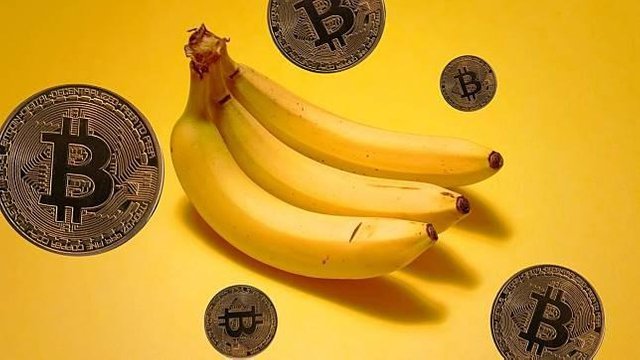Welcome Bananacoin: Crypto Money Connected Directly to Banana Prices in the Real World

The last time I met a parent, I was asked a lot of questions about Bitcoin (honestly, I do not understand anything about Bitcoin). They were very excited about the acquaintance who just bought Bitcoin to "fill his house." I was initially a bit confused, after being confirmed again, it turns out my orthuku is wrong, their friend bought Amazon Echo. Just because I was in the millenial category, my father and mother thought I must have understood outside of the phenomenon of crypto currency. Now, after a little learning the ins and outs of Bitcoin let me look kudet baseball, why have appeared new again: Bananacoin. What is that?!
When I first saw the Bananacoin information on the Internet, I gawked. Is this banana a virtual currency or what is it? After browsing for a while, borrowing the developer's remark, the bananacoin essentially is "a Ethereum-based currency system, which refers to the price of a kilogram of bananas in the real world." Well, bananacoin is a real crypto currency, just like Bitcoin who is constantly talking about your friends hanging out together, when he's just investing in the last two months. Just, admittedly, Bananacoin is not a regular virtual currency. Financial Express explains when Bananacoin is based on real commodities. So, we can treat it, "a kind of contract for the purchase of a certain amount of commodity in the future." How come? Because the reference source of the rise and fall of Bananacoin prices is based on the price of 1 kilogram of bananas in plantations in the country of Laos.
The team that created Bananacoin involved two Russian entrepreneurs, as well as an agricultural expert from Thailand. They have since three years ago collaborated to develop a banana plantation near the capital city of Vientiane. These three early investors hope Bananacpin can be an additional investment to expand their lands in the future. Now, the land that they planted banana is 100 hectares. Using the Bananacoin funding scheme, all three hope to expand the expansion to 360 hectares in the next 18 months. That is, Bananacoin is a combination of the crypto currency system as well as crowdfunding.
Bananacoin's creators are optimistic that their virtual currency will be greeted by the market, as there is real money involved in the banana business. In addition, their belief comes from successfully cultivating the 'Lady Finger Banana'-a premium banana type-which is exported to China because of its ever-high market demand. Their idea seems to have also welcomed the crypto currency market. One analyst stated, "Bananas should be recognized is an attractive investment instrument." How come? "Because for the past seven years, the price of one kilogram of bananas in the international market has increased steadily in the range of 4 percent to 10 percent."
Bananacoin investors may be more optimistic after an explanation from observers of the banana market (yes, there is a profession in the world). Lady Finger is a very different kind of banana from cavendish. You often buy bananas in the yellow fruit shop bright and fat? Well that's cavendish, the kind that is predicted to dominate 99 percent of export banana commodities. Lady finger is not better than cavendish, but it's at least pest free. The cavendish variant of recent years has been heavily attacked by a fungal pest, dubbed "the disease of Panama." Due to the rise of these pests, supply of bananas from various producer countries are often up and down.
Make no mistake, the supply of bananas the world never plummeted badly because of pests you know. It happened in early 1900'an. At that time the most widely sold bananas in the world is a variant of agricultural engineer development called Gros Michel. So the bananas are named "Big Mike" type. Big Mike's success turned out to have a bad impact. Many banana plantations only cultivate Big Mike. Finally, when the mushroom pest appeared, the harvest failed miserably.
Mid-20th century, almost all the gardens planted a variant of Big Mike harvest failure due to Panamanian Disease. The world's largest banana producer at the time, Uniterd Fruit Company, was forced to switch to a new type: Cavendish. The banana was once thought to be immune to the disease of Panama. Spoiler: proved, that assumption is wrong.
And reflecting on that history, the Bananacoin team did not want to repeat the same mistake. They implemented several countermeasures to prevent their bananas from getting pests. Among these are localized banana gardens from other plants. This policy is good, considering the Laotian Times newspaper reported November 2017, if some Cavendish banana plant in Laos was attacked by Panama disease.
By the way, let's go back to review Bananacoin. Its developers claim the profit of investing money in Bananacoin there are many. In addition to stable banana prices, the return of capital can be calculated more carefully, this type of investment is also easy to understand the layman-including our parents who are somewhat clueless. "To get involved in Bananacoin investments ... you do not need to have a qualified knowledge of cryptography or blockchain technology," the developer explains, referring to their published papers.
Until 23 January, reported 3.4 million Bananacoin tokens are already sold in the market. The current per token price is US $ 0.50 (equivalent to Rp6.700). OK. Sometimes when my parents wonder about crypto currency, I directed them to learn this one aja deh.
Cool article Bro ;) Check my profile if you want to follow me i too speak of crypto currencies ;).